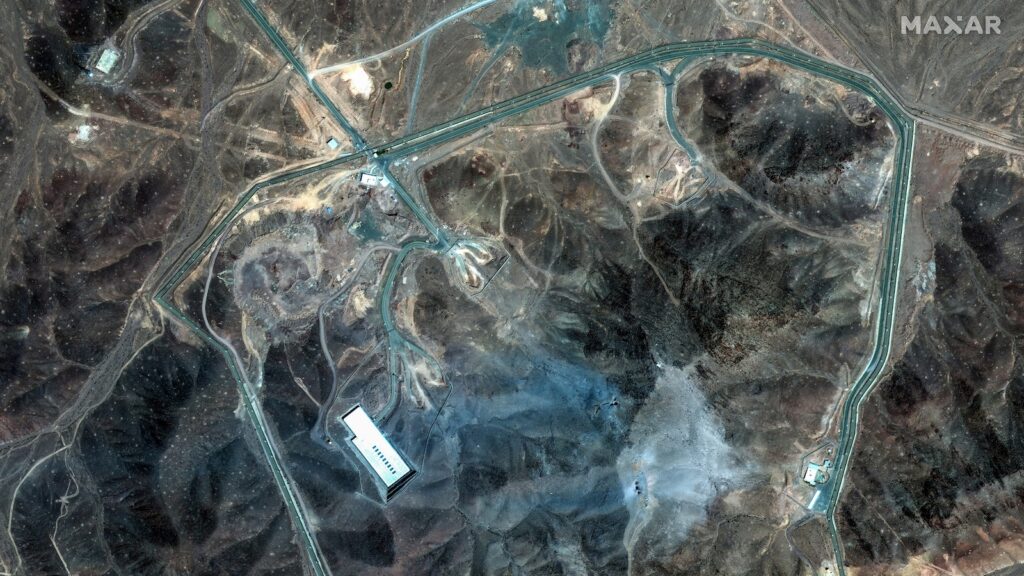
In a dramatic escalation of tensions, the United States launched a series of airstrikes targeting Iran’s key nuclear facilities, leaving significant destruction in their wake. The operation, dubbed “Midnight Hammer,” focused on three main sites: Fordo, Isfahan, and Natanz. Satellite imagery, provided by Maxar Technologies, offers a first glimpse into the extent of the damage inflicted by the strikes on June 22, 2025.
President Donald Trump declared the facilities “completely and totally obliterated,” yet officials have urged caution, noting that a comprehensive battlefield damage assessment is still pending. “Initial battle damage assessments indicate that all three sites sustained extremely severe damage and destruction,” stated Gen. Dan Caine, Chairman of the Joint Chiefs of Staff, during an interview with ABC News.
Fordo Nuclear Site: A Closer Look
Fordo, located approximately 60 miles south of Tehran, is a pivotal site for Iran’s uranium enrichment efforts. Satellite images reveal significant damage, characterized by large craters and a layer of blue ash, likely resulting from the use of Massive Ordinance Penetrators (MOPs). “It is clear that Fordo was directly impacted, but the degree of damage inside the uranium enrichment halls can’t be determined with certainty,” noted Rafael Grossi, Director General of the International Atomic Energy Agency (IAEA).
Experts have identified multiple craters, suggesting a concentrated attack on the facility’s ventilation shafts. “This all suggests to us the facility has probably been severely damaged,” commented Sam Lair from the Middlebury Institute’s James Martin Center for Nonproliferation Studies. However, the extent of the internal damage remains uncertain until further inspection is possible.
Additionally, the entrances to Fordo’s underground tunnels appear obstructed by dirt, raising questions about whether this was a defensive measure by Iranian forces or a result of the strikes. “The US may have attempted to strike the tunnel entrances, but we also saw trucks and other heavy equipment covering them with dirt two days ago,” explained Jeffrey Lewis, a nonproliferation expert.
Isfahan Nuclear Technology Center: Extensive Destruction
The Isfahan Nuclear Technology Center, situated in central Iran, has also suffered extensive damage. Satellite images depict numerous destroyed buildings, adding to the devastation caused by previous Israeli attacks. “The latest attacks early this morning damaged other buildings in Esfahan. In addition, we have established that entrances to underground tunnels at the site were impacted,” Grossi confirmed.
The U.S. strikes appear to have targeted the uranium conversion facilities, causing widespread destruction across the site. This marks a significant blow to Iran’s nuclear capabilities, as these facilities play a critical role in the country’s nuclear program.
Natanz Nuclear Facility: Focus on Underground Structures
Natanz, Iran’s largest nuclear enrichment center, has been a focal point of international concern. The latest satellite images reveal an 18-foot diameter crater directly over part of the underground military complex, indicating a targeted strike on the facility’s subterranean structures. “The presence of one large crater at Natanz shows that multiple MOPs were used on the facility hitting the same crater more than once, to improve the depth of penetration,” experts told ABC News.
Prior to the U.S. strikes, Israeli attacks had already inflicted significant damage on Natanz’s above-ground infrastructure, including power supply systems and emergency generators. The recent focus on underground facilities suggests a strategic shift aimed at crippling Iran’s nuclear capabilities at their core.
Implications and Future Considerations
The U.S. strikes on Iran’s nuclear sites represent a significant escalation in the ongoing geopolitical tensions between the two nations. The destruction of these facilities could have far-reaching implications for regional stability and global nuclear nonproliferation efforts. As the international community awaits a full assessment of the damage, questions remain about the potential for further military actions and the broader impact on diplomatic relations.
As experts continue to analyze the aftermath of the strikes, the world watches closely for Iran’s response and any potential repercussions on the global stage. The situation underscores the fragile nature of international diplomacy in the nuclear age and the critical need for continued dialogue and negotiation to prevent further escalation.






